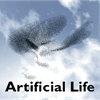Camouflage From Coevolution of Predator and Prey
IF 1.5
4区 计算机科学
Q4 COMPUTER SCIENCE, ARTIFICIAL INTELLIGENCE
引用次数: 0
Abstract
Camouflage in nature seems to arise from competition between predator and prey. To survive, predators must find prey, while prey must avoid being found. A simulation model of that adversarial relationship is presented here. Camouflage patterns of prey coevolve in competition with visual perception of predators. During their lifetimes, predators learn to better locate the camouflaged prey they encounter. The environment for this 2-D simulation is provided by photographs of natural scenes. The model consists of two evolving populations, one of prey and another of predators. Conflict between these populations produces both effective prey camouflage and predators able to “break” camouflage. The resulting open-source Artificial Life model can help the study of camouflage in nature and the perceptual phenomenon of camouflage more generally.捕食者和猎物共同进化的伪装。
自然界中的伪装似乎是由捕食者和猎物之间的竞争产生的。为了生存,捕食者必须找到猎物,而猎物必须避免被发现。本文给出了这种对抗关系的仿真模型。猎物的伪装模式在与捕食者的视觉感知竞争中共同进化。在它们的一生中,捕食者学会更好地定位它们遇到的伪装猎物。这个二维模拟的环境是由自然场景的照片提供的。该模型由两个进化种群组成,一个是猎物,另一个是捕食者。这些种群之间的冲突既产生了有效的猎物伪装,也产生了能够“打破”伪装的捕食者。由此产生的开源人工生命模型可以帮助研究自然界的伪装和更广泛的伪装感知现象。
本文章由计算机程序翻译,如有差异,请以英文原文为准。
求助全文
约1分钟内获得全文
求助全文
来源期刊

Artificial Life
工程技术-计算机:理论方法
CiteScore
4.70
自引率
7.70%
发文量
38
审稿时长
>12 weeks
期刊介绍:
Artificial Life, launched in the fall of 1993, has become the unifying forum for the exchange of scientific information on the study of artificial systems that exhibit the behavioral characteristics of natural living systems, through the synthesis or simulation using computational (software), robotic (hardware), and/or physicochemical (wetware) means. Each issue features cutting-edge research on artificial life that advances the state-of-the-art of our knowledge about various aspects of living systems such as:
Artificial chemistry and the origins of life
Self-assembly, growth, and development
Self-replication and self-repair
Systems and synthetic biology
Perception, cognition, and behavior
Embodiment and enactivism
Collective behaviors of swarms
Evolutionary and ecological dynamics
Open-endedness and creativity
Social organization and cultural evolution
Societal and technological implications
Philosophy and aesthetics
Applications to biology, medicine, business, education, or entertainment.
 求助内容:
求助内容: 应助结果提醒方式:
应助结果提醒方式:


